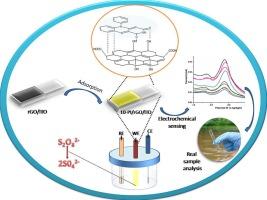Novel electrochemical sensor based on reduced graphene oxide/10-phenylisoalloxazine for detection of persulfate
IF 4.1
3区 化学
Q1 CHEMISTRY, ANALYTICAL
引用次数: 0
Abstract
A novel and precise electrochemical sensor utilizing a 10-phenylisoalloxazine (PI)/reduced graphene oxide (rGO) modified indium tin oxide (PI/rGO/ITO) electrode was developed and employed for the detection of persulfate (S2O82−). In the present study, developed rGO was initially deposited onto ITO coated glass substrate using an electrophoretic deposition process. Then the rGO/ITO electrode was activated by coating PI using the drop-casting method. The techniques of FTIR, Raman spectroscopy, UV–vis, XRD, and scanning electron microscopy (SEM) were employed to characterize the components and electrode. The constructed sensor (PI/rGO/ITO), under all optimized conditions, exhibited exceptional sensitivity 36.29 μA(μM)−1 cm−2 with a low detection limit (LOD) of 0.19 μM and a linear correlation with S2O82−concentration spanning from 1 μM to 80 μM. Furthermore, this newly developed sensor demonstrated impressive stability and sensitivity, effectively identifying S2O82− in real samples with commendable results.

基于还原氧化石墨烯/10-苯基异alloxazine的新型电化学传感器检测过硫酸盐
利用10-苯基异alloxazine (PI)/还原氧化石墨烯(rGO)修饰氧化铟锡(PI/rGO/ITO)电极,研制了一种新型精密电化学传感器,并将其用于过硫酸盐(S2O82−)的检测。在本研究中,开发的氧化石墨烯最初使用电泳沉积工艺沉积在ITO涂层玻璃基板上。然后采用滴铸法涂覆PI活化rGO/ITO电极。采用红外光谱(FTIR)、拉曼光谱(Raman spectroscopy)、紫外可见光谱(UV-vis)、x射线衍射(XRD)、扫描电镜(SEM)等技术对其组成和电极进行了表征。在所有优化条件下,所构建的传感器(PI/rGO/ITO)的灵敏度为36.29 μA(μM)−1 cm−2,低检出限(LOD)为0.19 μM,与S2O82−浓度在1 ~ 80 μM范围内呈线性相关。此外,这种新开发的传感器表现出令人印象深刻的稳定性和灵敏度,有效地识别了实际样品中的S2O82−,并取得了令人称赞的结果。
本文章由计算机程序翻译,如有差异,请以英文原文为准。
求助全文
约1分钟内获得全文
求助全文
来源期刊
CiteScore
7.80
自引率
6.70%
发文量
912
审稿时长
2.4 months
期刊介绍:
The Journal of Electroanalytical Chemistry is the foremost international journal devoted to the interdisciplinary subject of electrochemistry in all its aspects, theoretical as well as applied.
Electrochemistry is a wide ranging area that is in a state of continuous evolution. Rather than compiling a long list of topics covered by the Journal, the editors would like to draw particular attention to the key issues of novelty, topicality and quality. Papers should present new and interesting electrochemical science in a way that is accessible to the reader. The presentation and discussion should be at a level that is consistent with the international status of the Journal. Reports describing the application of well-established techniques to problems that are essentially technical will not be accepted. Similarly, papers that report observations but fail to provide adequate interpretation will be rejected by the Editors. Papers dealing with technical electrochemistry should be submitted to other specialist journals unless the authors can show that their work provides substantially new insights into electrochemical processes.

 求助内容:
求助内容: 应助结果提醒方式:
应助结果提醒方式:


